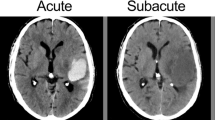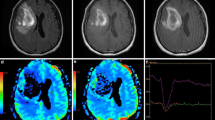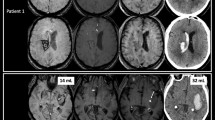Abstract
We evaluated a method for quantifying vasogenic edema (VE) on MRI to identify brain hematomas caused by neoplasms. We performed a blinded review of 68 acute and subacute hematomas caused by neoplasms (22), hypertension or presumed amyloid angiopathy (27), or vascular malformations (19). The extent of vasogenic edema was quantified on an axial T2-weighted image using the VE ratio: the maximum width of high signal surrounding a hematoma and the mean diameter of the hematoma. Hematomas caused by neoplasm were associated with more vasogenic edema (mean VE ratio 104%±15%; mean VE width 2.4±0.7 cm) than non-neoplastic hematomas (mean VE ratio 37%±5%; P =0.001). When the width of VE was equal to or more half the diameter the hematoma (VE ratio 50%), the positive predictive value for tumor was 66%; when it was equal to or more than the diameter, the positive predictive value was 71%. All six hematomas with VE ratios ≥150% were caused by neoplasm.





Similar content being viewed by others
References
Adams R, Victor M, Ropper A (1997) Principles of neurology, 6th edn. McGraw-Hill, New York, pp 834–841
Mutlu N, Berry R, Alpers B (1963) Massive cerebral hemorrhage. Clinical and pathological correlation. Arch Neurol 8: 644–661
Scott M (1975) Spontaneous intracerebral hematoma caused by cerebral neoplasms. J Neurosurg 42: 338–342
Griffiths P, Beveridge C, Gholkar A (1997) Angiography in non-traumatic brain hematoma. Acta Radiol 38: 797–802
Dylewski D, Morgenstern L, Demchuk A (2000) Utility of magnetic resonance imaging in acute intracerebral hemorrhage. J Neuroimaging 10: 78–83
Bradley W (1993) MR appearance of hemorrhage in the brain. Radiology 189: 15–26
Osborn A (1994) Diagnostic neuroradiology. Mosby-Yearbook, St Louis, pp 166–167
Nussbaum E, Heros R, Camarata R (1995) Surgical treatment of intracranial arteriovenous malformations with an analysis of cost-effectiveness. Clin Neurosurg 42: 348–369
Duffau H, Capelle L, Sichez JP, et al (1997) Early radiologically proven rebleeding from intracranial cavernous angiomas: report of 6 cases and review of the literature. Acta Neurochir (Wien) 139: 914–922
Atlas S, Grossman R, Gomori J, et al (1987) Hemorrhagic intracranial malignant neoplasms: spin-echo MR imaging. Radiology 164: 71–77
Inzitari D, Giordano G, Ancona A, Pracucci G, Mascalchi M, Amaducci L (1990) Leukoaraiosis, intracerebral hemorrhage, and arterial hypertension. Stroke 21: 1419–1423
Chappell P, Steinberg G, Marks M (1992) Clinically documented hemorrhage in cerebral arteriovenous malformations: MR characteristics. Radiology 183: 719–724
Greenberg S, Finkelstein D, Schaefer P (1996) Petechial hemorrhages accompanying lobar hemorrhage: detection by gradient-echo MRI. Neurology 46: 1741–1754
Offenbacher H, Fazekas F, Schmidt R, Koch M, Fazekas G, Kapeller P (1996) MR of cerebral abnormalities concomitant with primary intracerebral hematomas. AJNR 17: 573–578
Tanaka A, Ueno Y, Nakayama Y, Takano K, Takebayashi S (1999) Small chronic hemorrhages and ischemic lesions in association with spontaneous intracerebral hematomas. Stroke 30: 1637–1642
Wakai S, Yamakawa K, Manaka S, Takakura K (1982) Spontaneous intracranial hemorrhage caused by brain tumor. Its incidence and clinical significance. Neurosurgery 10: 437–444
Zimmerman H (1984) The pathology of primary brain tumors. Semin Roentgenol 19: 129–138
Berkman R, Merrill M, Reinhold W, et al (1993) Expression of vascular permeability factor/vascular endothelial growth factor gene in central nervous system neoplasms. J Clin Invest 91: 153–159
Strugar J, Criscuolo G, Rothbart D, Harrington W (1995) Vascular endothelial growth/permeability factor expression in human glioma specimens: correlation with vasogenic brain edema and tumor-associated cysts. J Neurosurg 83: 682–689
McLone D (1980) Ultrastructure of the vasculature of central nervous system tumors of childhood. Child's Brain 6: 242–254
Criscuolo G (1993) The genesis of peritumoral vasogenic brain edema and tumor cysts: a hypothetical role for tumor-derived vascular permeability factor. Yale J Biol Med 66: 277–314
Little J, Dial B, Belanger G, Carpenter S (1979) Brain hemorrhage from intracranial tumor. Stroke 10: 283–288
Zimmerman R, Bilaniuk L (1980) Computed tomography of acute intratumoral hemorrhage. Radiology 135: 355–359
Senger D, Brown L, Claffey K, Dvorak H (1994) Vascular permeability factor, tumor angiogenesis and stroma generation. Invasion Metastasis 14: 385–394
Earnest FT, Kelly P, Scheithauer B, et al (1988) Cerebral astrocytomas: histopathologic correlation of MR and CT contrast enhancement with stereotactic biopsy. Radiology 166: 823–827
Coakley K, Huston Jr, Scheithauer B, Forbes G, Kelly P (1995) Pilocytic astrocytomas: well-demarcated magnetic resonance appearance despite frequent infiltration histologically. Mayo Clin Proc 70: 747–751
Author information
Authors and Affiliations
Corresponding author
Rights and permissions
About this article
Cite this article
Tung, G.A., Julius, B.D. & Rogg, J.M. MRI of intracerebral hematoma: value of vasogenic edema ratio for predicting the cause. Neuroradiology 45, 357–362 (2003). https://doi.org/10.1007/s00234-003-0994-0
Received:
Accepted:
Published:
Issue Date:
DOI: https://doi.org/10.1007/s00234-003-0994-0




